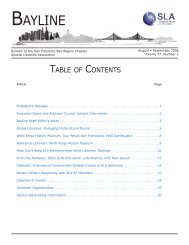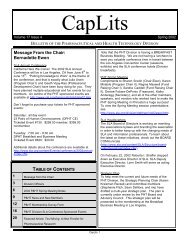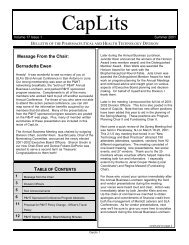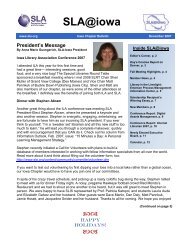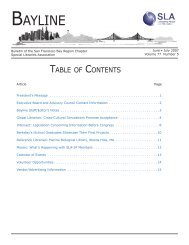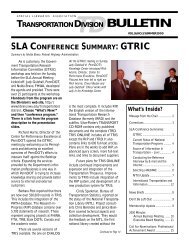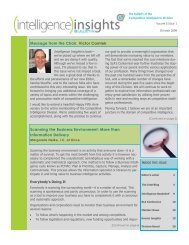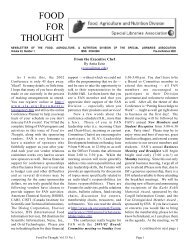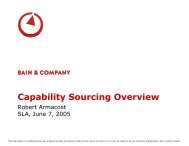Education Libraries - Special Libraries Association
Education Libraries - Special Libraries Association
Education Libraries - Special Libraries Association
You also want an ePaper? Increase the reach of your titles
YUMPU automatically turns print PDFs into web optimized ePapers that Google loves.
� Know the organization of periodical<br />
databases<br />
The chapter includes websites on searching periodical<br />
databases.<br />
Chapter 6 provides the instructor with some useful tips<br />
for bibliographic instruction, such as explaining the<br />
Library of Congress classification scheme and<br />
interpreting a call number. The examples are excellent<br />
quizzes for students, though they should be adapted for<br />
additional disciplines. This chapter is the only one that<br />
perhaps provides too much detail for the average<br />
student, though the concept is well worth covering<br />
within any information literacy course as it is unlikely to<br />
be addressed elsewhere, in any other formal course or<br />
informal training.<br />
Learning to search online public access catalogs<br />
(OPACs) for relevant resources is the goal of Chapter 7.<br />
The chapter provides activities that will help the<br />
instructor persuade students to use Library of Congress<br />
subject headings as a search tool, teaching them how to<br />
find LC Subject Headings in the “Red Books” and<br />
compare LC Subject Heading to keyword searching. The<br />
final learning objective of the chapter is to help students<br />
recognize when they need to search beyond OPACs.<br />
Chapter 8 focuses on teaching students how to evaluate a<br />
book by its internal features (i.e., author, title page,<br />
additional front matter) and its content. The chapter<br />
concludes by providing a summary of where scholarly<br />
evaluations of books can be found; hence, the chapter’s<br />
title, Researching Book Reviews. The examples<br />
provided here will help any instructor think of relevant<br />
assignments to test whether students have mastered the<br />
subject matter.<br />
Searching the Internet effectively is difficult. Chapter 9<br />
provides a guide for using basic Internet finding tools,<br />
such as search engines, meta-search engines, subject<br />
directories, hybrids and portals, with a discussion of the<br />
deep web and techniques for keeping current. Learning<br />
objective 2, “Preparing and executing a Internet search<br />
strategy” recommends eight steps:<br />
1. Articulate the search topic<br />
2. Know what is needed<br />
3. Develop a logical search statement<br />
4. Construct a query<br />
5. Know the search features of each search<br />
engine<br />
6. Examine the results<br />
7. Modify the search strategy<br />
8. Evaluate the trustworthiness of a site as<br />
well as the accuracy of its content.<br />
The final chapter focuses on evaluating Internet-based<br />
resources. According to the author, the goal of<br />
determining the authority and accuracy of websites<br />
consists of four learning objectives:<br />
1. Know how to detect inaccurate<br />
information<br />
2. Recognize a “possible” trustworthy site<br />
3. Investigate and verify ownership of<br />
information<br />
4. Know major website types that can<br />
mislead.<br />
This practical work for information literacy instruction<br />
presents its material in a logical flow and format, and is<br />
an excellent resource for all interested in the subject, in<br />
particular, high school and community (two-year)<br />
college librarians.<br />
Barbie E. Keiser is a information resources<br />
management consultant located in the metro-<br />
Washington, DC, area. Email: barbieelene@att.net<br />
Curriculum<br />
Leadership:<br />
Development and<br />
Implementation—<br />
Reviewed by Gail K.<br />
Dickinson<br />
Glatthorn, Allan A,<br />
Boschee, Floyd, and<br />
Whitehead, Bruce M.<br />
(2006). Curriculum<br />
Leadership:<br />
Development and<br />
Implementation. Los<br />
Angeles: Sage. 978-1-<br />
4129-0426-1. $91.95.<br />
To say that Curriculum Leadership is a thorough<br />
approach to the study of curriculum development and<br />
implementation is an understatement. The hefty 468<br />
page volume is packed with the background, current<br />
issues, and further projected developments necessary to<br />
understand each stage of the curriculum study process.<br />
Glatthorn, Boschee, and Whitehead begin the book with<br />
<strong>Education</strong> <strong>Libraries</strong>, Volume 31, No. 2, Winter 2008 51



